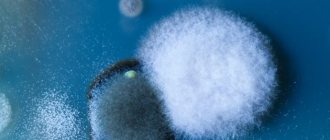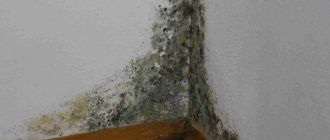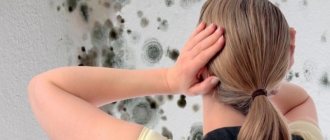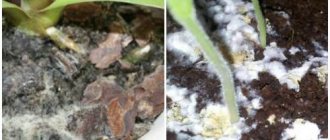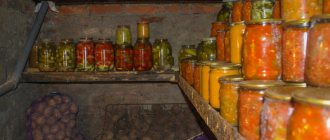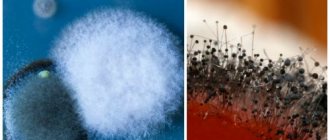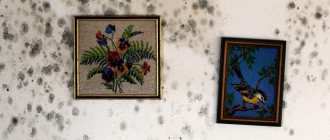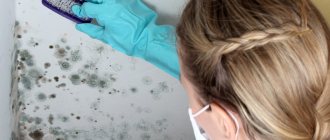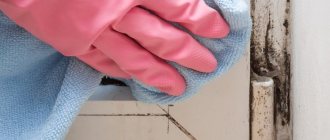Black mold on the walls in the apartment, which many people simply do not notice in their homes. There can be small dark spots on walls, cracks and other surfaces, or huge “fluffy” mold spots. Such spots are black mold on the walls in the apartment, a dangerous fungal formation. We'll look at how to get rid of it in this article.
Black mold on the walls of an apartment is quite common. Many people live with it for years, suffering from chronic diseases and mycosis. Needless to say, you should get rid of black mold on the walls, ceiling or floor in your apartment as soon as possible. Ordinary black mold on the wall in an apartment can cause a colossal number of illnesses; such cohabitation is especially dangerous for young children.
Black mold (there may be other strains of the microorganism) belongs to a genus of mold fungi that can cause serious human illness . It is often used for industrial purposes to make citric acid, but in an apartment or house it poses a great danger.
In order to permanently get rid of black mold on the walls in an apartment with a guarantee, just call the phone number listed on the website. Our specialists will carry out a set of measures to remove black mold from the walls and ceiling of your apartment.
Why is black mold dangerous?
This type of fungus can cause serious health problems. In the stage of constant reproduction (in the presence of abundant moisture), it is found almost everywhere: on the surfaces of kitchen appliances, tables, toothbrush handles, and even in foods. It enters the lungs with air, which leaves a noticeable imprint on their condition.
If there is black mold on the walls in the apartment, then you can expect the following to occur:
- Allergies;
- Poor health and constant fatigue;
- Lung problems: bronchitis, asthma;
- Constant headache;
- Colds;
- Reduced effectiveness of the immune system;
- Exacerbation of existing diseases;
- Nausea and poisoning;
- Diarrhea.
Children's bodies are especially susceptible to fungal spores. A child may constantly feel tired, weak, refuse to eat, literally attract colds, not play or show interest in anything.
Pets can also be the first to get sick when a microorganism appears. If there are changes in their behavior, pay special attention to the presence of mold.
You should not underestimate the black mold that appears on the walls of your apartment. Its spores are carried by air, which contributes to rapid spread throughout the entire housing area. When the first signs of black spots appearing on the walls in your home, you should immediately try to get rid of them. If this is not done, then in a couple of weeks the struggle will become more global in nature.
Black Aspergillus or black mold can be considered the most dangerous type of mold. It is he who causes the greatest harm to the human body and there are cases when it caused death.
Types of pathogenic microorganism
Let us briefly describe the main strains known as “black mold”.
- Aspergillus niger. A saprophytic fungus that settles in damp, warm places. Feels good in the bathroom, on damp books, in air conditioners, etc. Dangerous for health.
- Aspergillus fumigates. Initially lives on affected vegetables or fruits. Under favorable circumstances, it moves to any other surfaces. Dangerous for allergy sufferers and children.
- Cladosporium. Settles inside and outside residential premises. May be dangerous for people with weakened immune systems.
- Chaetomium. Quite rarely found indoors, it can live on any surface. If it enters the gastrointestinal tract, it causes severe poisoning, which can be fatal.
- Penicillium. Lives on a variety of surfaces. In industry it is used for the production of medicines and exclusive cheeses. Safe for people, with the exception of a few strains.
A non-specialist will not be able to determine the type of pathogenic microflora by appearance. Therefore, the same means are used to combat it. Although it is believed that aspergillus strains most often settle in homes.
Black mold in the bathroom
A humid environment is optimal for the development of Aspergillus nigra or black mold. That is why the bathroom in most cases becomes the center of its spread. Mold is also sometimes found outdoors, but in open spaces it is practically harmless.
More information about fungus in the bathroom is written in our article - how to get rid of mold in the bathroom.
Reasons for appearance
The main reason is constantly high air humidity, temperatures above +15 degrees and lack of good ventilation in the room. Also, the lack of periodic treatment of surfaces with cleaning agents creates an ideal environment for the development of fungus. Under such environmental conditions, its appearance is only a matter of time.
Probable causes of appearance
Mold is a type of microorganism that exists in nature; another name is fungus. Mold is actually microscopic fungi. They emit an unpleasant odor and are toxic to humans and pets. Mold spores are almost invisible, which makes the process of eliminating mold much more difficult. Thanks to this property, microscopic fungi are able to penetrate small crevices and begin to actively reproduce.
Mold can be painted in various colors (pink, white and others); in apartments, the presence of black fungi is most often noted. The spores of this microorganism are found everywhere: in water, on the ground, other surfaces, even on the keyboard (if you forget to wipe it regularly with a damp cloth).
To successfully get rid of mold in an apartment, you need to know the causes of fungus in the house. Experts identify several probable causes of the appearance of fungal formations:
- high humidity. The presence of high humidity is one of the main negative factors that affects the occurrence of mold. This is why fungus often settles on the ceiling, walls in the bathroom, kitchen;
- insufficient ventilation. Poor performance of the ventilation system leads to the retention of pathogenic microorganisms in the room and their settling on various surfaces. Most often, this process is observed in the bathroom; many complain about the presence of black spots on the ceiling and walls of the room. Often such problems arise due to the installation of plastic windows, which disrupts the natural ventilation in the apartment;
- hypothermia of the walls, which is observed in winter. The situation occurs when mistakes are made during the construction of a house;
- presence of cracks in the walls of the apartment. Unnecessary moisture enters the house through the holes, creating favorable conditions for the proliferation of mold spores. The trouble arises against the backdrop of unsuccessful repairs, careless replacement of wooden windows with plastic ones, and failure to comply with technical recommendations;
- poorly sealed interpanel seams, which opens the way for pathogenic microorganisms. A problem arises due to the use of low-quality sealant, if the correct technology for this process is not followed.
There are a lot of negative factors; it is important to find out the specific cause of mold in the apartment and eliminate it. Only then should you remove the existing fungus.
How to get rid of rats in a private home and prevent the reappearance of rodents? We have the answer!
What to do if mold appears in a flower pot and how to get rid of it? Read useful tips on this page.
Black mold on the walls in the apartment
Sometimes it happens that black mold on the walls of an apartment can appear on walls, ceilings, and other surfaces of living rooms, such as windows.
This slideshow requires JavaScript.
Reasons for appearance on the walls
If everything is clear with the bathroom, then at first glance there are no obvious reasons for the appearance of black mold on the walls in the apartment. In fact, it is enough to not completely dry the carpet once or simply spill water on it for it to become a good breeding ground for fungus.
It can also multiply in wood and other materials that can retain moisture for a long time. The causes of fungus can also be:
- Incorrect installation of plastic windows . If the rules for installing plastic windows are violated, the microclimate of the room may be disrupted. We devoted an article to this topic - Getting rid of mold on windows.
- Poor heating . Moisture is not dried out, which accelerates the growth of mold fungi. Read our instructions on how to deal with humidity.
- Rare ventilation. In this case, the concentration of pores in the air is maximum.
Installing plastic windows in an apartment makes the rooms literally hermetically sealed: air does not enter or exit. Under conditions of poor heating or increased humidity, such an environment is almost ideal for the growth of microorganisms.
When cleaning your apartment, pay special attention to the windows . It is near them that the fungus most often begins to appear.
What is mold and its danger to humans?
Mold that appears on walls is an accumulation of a large number of living organisms. The establishment of a mold colony begins with just 1 spore attaching itself to the ceiling, walls, furniture, fabric or other material. This requires favorable conditions.
The most optimal temperature for these microorganisms is +19…+21°C. In this case, the humidity level should be about 80%. If conditions become unfavorable, some of the colony may die, but most molds will survive. These organisms require a nutrient medium. It could be:
- concrete;
- tree;
- brick;
- plaster;
- drywall;
- varnished surfaces;
- paper products;
- textile;
- leather, etc.
First, a small dot appears on the wall, ceiling or other surface. Subsequently, this outbreak quickly grows, occupying large areas. Mature mold begins to release large amounts of spores into the air. This contributes to the appearance of other foci of mold in the room. Most people have seen fungus on walls; few know why it is dangerous.
An increase in the area of mold growth and the number of spores in the air can adversely affect the health of residents. If there is mold in the apartment, people living in the room may experience:
- slow exhaustion;
- nosebleeds;
- frequent headaches;
- disruption of the gastrointestinal tract;
- pathologies of the respiratory system;
- rheumatic diseases;
- allergic reactions;
- dermatitis.
The risk group for developing severe diseases due to mold infection includes the elderly and children. In addition, mold is extremely dangerous for people suffering from immunodeficiency.
Inhalation of spores and contact with skin
The high content of mold spores in the air causes them to settle on a person’s skin and enter his respiratory system. This can cause the development of extremely serious conditions. Children and adults living in homes with moldy walls and ceilings are at increased risk of developing severe allergic reactions.
Inhalation of spores against a background of reduced immunity can provoke the development of fungal pneumonia. This condition is extremely dangerous, because... To eliminate microorganisms, highly toxic drugs must be used.
People who have not previously encountered an excess of fungal spores in the air may develop Quincke's edema and anaphylactic shock. It is believed that mold, when entering the body, can cause cell mutation and the formation of malignant tumors in the lungs. Black mold is considered especially dangerous in this regard.
Under some circumstances, spores deposited on the skin can cause the development of dermatitis and mycoses. People who use a bathroom with moldy walls often encounter a similar problem. In addition, these microorganisms can provoke malignant degeneration of skin cells.
Professional products to combat black mold
They can be found on the shelves of hardware stores or purchased online. The effectiveness of use depends solely on the manufacturer and composition. The main thing is to strictly follow the manufacturer’s instructions and also take into account possible harm to finishing materials and the body.
Treatment of mold in an apartment using aggressive agents should be carried out using thick rubber gloves and protective equipment for the eyes and respiratory tract.
What to do in case of extensive lesions
Well, it is impossible not to highlight the method of combating fungus and mold, which is rightfully called the most radical and effective.
- Those places where black mold has formed on the walls are completely cleaned and, if necessary, a layer of material is removed with a handy power tool.
- In case of significant damage, all affected finishing materials are removed. After completely cleaning the walls, ceiling and floor, they are thoroughly dried and treated with special products.
Just keep in mind that this method of fighting is the most expensive. In fact, you will have to renovate the bathroom or another room.
Groups of microorganisms in mold
Microorganisms in mold are divided into the following groups?
- The first group includes mold fungi. They affect building materials (concrete, stone) and surfaces treated with paint, plaster, and wallpaper. They come in a variety of colors, including black. They are clearly visible in contaminated areas, including on the walls of homes. At first they are located pointwise, and then form spots of points, gradually increasing in size. Some fungi from this group are able to glow in the dark.
- The second group consists of blue fungi. They have a detrimental effect on tree species, especially pine. Owners of wooden buildings should be attentive to this type of mold, protecting their buildings with preventive treatments.
- The third group is represented by putrefactive fungi. This is a brown microorganism that destroys all wood, without exception. Putrefactive changes appear as black (or other colored) stripes on wooden surfaces.
It belongs to the first group of microorganisms and has a detrimental effect on the human body. It is especially dangerous for older and younger age groups, people with weak immune systems and expectant mothers.
Prevention against black mold
To avoid becoming a victim of harmful fungi or to prevent their reappearance after they have been destroyed, you need to adhere to some basic rules:
- Heating of all rooms in the housing must be sufficient to prevent excess humidity in each of them.
- Monitor the number of indoor plants in the apartment and make it optimal (moisture when watering them makes the air humid).
- Don't forget to ventilate the entire apartment. The fungus doesn't like this very much. When ventilating in cold seasons, you should not open the windows for a long time to avoid cooling the walls.
- Hang laundry only outside the apartment. If you constantly neglect this rule, mold will certainly appear in your home soon.
- When carrying out repairs, choose materials that are unable to accumulate a lot of moisture.
- Insulate all surfaces that get very cold outside. For example, facade walls or the floor on a balcony.
- Ensure good ventilation in the bathroom and kitchen.
- To reduce the likelihood of black mold forming in your bathroom, install a good heated towel rail. It will reduce the amount of moisture and dry laundry and towels faster.
How to remove black mold from fabric
Many housewives have at least once in their lives encountered the problem of mold appearing on the surface of clothes and other fabric items. To get rid of this you can use the following methods:
- Black mold can be easily removed using any household products that contain chlorine. It is enough to apply this substance to the material, leave it for 15–20 minutes, after which you just need to wash the item in the usual way. It is worth noting that this method is not suitable for treating wool or colored fabrics due to the bleaching properties and possible damage to the product.
- For delicate types of fabric, you can use “Vanish”, which has a gentle effect without damaging it, while fighting fungus. The product is applied to the product, left for half an hour, then washed in the machine with the addition of it.
- In addition, you can mix vinegar with lemon juice (you can take citric acid and dilute it in water) and apply the resulting mixture to the location of the fungus, after an hour you need to wash the clothes.
- Hardware stores sell special products whose main task is to combat stains; they work very effectively and do not damage the material; the main thing is to follow the instructions on the packaging.
- Apply a little ammonia diluted with water to the mold and wash the item after a while.
- If the fungus has affected a large area of tissue, you can use hydroperite. You should take at least 30 tablets and dilute them in 5 liters of water. In this form, the fabric should be left overnight, and in the morning washed in a soap solution and rinsed thoroughly.
- It is good to remove mold from wool using turpentine; apply it directly to the stain using a sponge, leave for an hour, then wash the item in the usual way.
In order not to waste time thinking about how to remove mold stains from the surface of walls, bathroom tiles or clothes, you should maintain an acceptable level of humidity in your home. Do not leave wet things next to dry ones, adjust the ventilation and pay attention to timely drying of the room. This is the only way to prevent the appearance of fungus, which can have a negative effect on human health.
Professional removal of black mold
To begin with, it should be noted that the involvement of specialists allows us to obtain a comprehensive solution to the problem. Unlike self-treatment of walls with means, they carry out a complex of actions:
- Complete analysis of the object's condition. Foci of fungus are detected. For this purpose, a thermal imager inspection or a mycological examination may be carried out.
- Choosing the optimal method for treating surfaces and drawing up a list of actions to eliminate the causes of mold development.
- Carrying out operations agreed with the owner of the apartment.
- Checking the work.
Surface treatment method
Different companies can use their own technologies. They are often determined depending on the current situation. But in most cases, the process of eliminating black mold on the walls and in the bathroom goes something like this:
- Problem areas are wetted with water to prevent the spread of spores during cleaning.
- Special solutions are applied to the surface of the coatings. After they dry, the process is repeated several times.
- Using special technical devices, the fungus is removed. In this case, the paintwork, wallpaper and even plaster are removed (the plaster can even penetrate into its structure). In some situations, concrete walls can even be milled.
- Defects in premises are eliminated, promoting the formation of an optimal environment for the growth of microorganisms. Cracks in walls, near windows, etc. can be covered up.
- Disinfection is in progress.
- The affected areas are well dried.
Microwave method or heating and drying walls from mold
This method of eliminating mold can be considered the most effective and safest. Its essence is to warm the infected areas to a high temperature. Technology Features:
- Size of treated area: 50x50;
- Warm-up depth: 30 cm (+ - 5 cm);
- The strength of the temperature effect is 65-70 degrees.
- The effectiveness of the method is due to the ability of the fungus to withstand temperatures up to 60 degrees. It is also worth considering that when operating a laser pyrometer, you can accurately control the level of heating.
This slideshow requires JavaScript.
The advantages of the microwave method include:
- Ability to process any surface;
- Fast completion of work;
- Processing even hard-to-reach places;
- There are no chemicals;
- Temperature passes through different materials.
Fighting black mold in the bathroom and on the walls of other rooms is simply necessary. Its presence can cause serious illnesses and a significant deterioration in the body’s condition.
At the initial stage of its appearance, you can use improvised means and try to get rid of the dangerous fungus yourself. But the most correct and rational way out if there is mold of black or other colors is to contact a specialist.
Only professionals will be able to solve the problem for a long time and make your home absolutely safe to live in. Moreover, the cost of their services is affordable in most cases. Just when choosing a company, be sure to ask about the possibility of using the technologies described above (microwave and others). This will guarantee that you order services from truly professionals.
How to remove fungus in an apartment using specialized means
Depending on the area affected and the complexity of the surface being treated, the market offers professional methods of combating black mold. The most popular are imported products.
Senezh Effo
A good option for porous materials, tiles and other hard surfaces . The liquid is economical in consumption.
Does not leave stains, self-neutralizes, suitable for processing food containers. On delicate materials it is recommended to dilute the product in a 1:1 ratio.
In other cases, the drug is applied to the area affected by the fungus using a sponge or brush. On vertical surfaces, processing is carried out from bottom to top.
The action of Senezh Effo takes place in the first 2-3 hours . Next, dry the surface naturally. If necessary, the treatment is repeated until the problem is completely eliminated.
If the treated area is designated for painting, the manufacturer recommends washing off the composition after 24 hours or waiting 10 days and painting.
Depending on the volume the price is as follows:
- 5 kg - about 500 rubles;
- 10 kg – approximately 900 rub.
Fongifluid (ALPA)
Suitable for use on external and internal areas infected with fungal spores. Nominal volume 2 l. Economical to use.
Suitable for porous and smooth surfaces. When used on paint and varnish surfaces, it increases their resistance to moisture. Leaves no traces. It does not have a pungent odor, which provides an advantage for use in enclosed spaces .
Before application, the surface is prepared. The areas are cleaned with a spatula, a metal brush, and, if necessary, washed with water.
Instructions:
apply the composition using a roller or brush,- leave for activation for 4-6 days,
- after the allotted time, remove any remaining product with a stiff brush, rinse off the surface with water,
- Allow the treated area to dry.
The manufacturer guarantees protection against fungus for 2 years.
Available in quantities:
- 0.5 l. - about 500 rub.,
- 2 l. - about 830 rubles,
- 5 l. - approximately 1650 rub.
Homeenpoisto (TIKKURILA)
The most aggressive of the drugs presented . Processing should be carried out only in a respirator, goggles and rubber gloves.
Not for use on glass, aluminum surfaces or other delicate areas. Strictly incompatible with detergents.
Before treating unpainted wood surfaces, prime with any antiseptic. The Finnish manufacturer recommends Valtti Pohjuste.
Next, dilute the drug concentrate with water 1:3 and apply for 30 minutes. sponge or brush . If the result is not satisfactory, treatment is not stopped until the fungus completely disappears.
All this time, the surface is kept moist using the product. Upon completion of application, the surface is thoroughly washed with water from top to bottom. The price will be for 1 liter. about 550 rub.
How much does it cost to get rid of black mold on the walls of an apartment? Prices
| Room area | Impregnation | Mechanical stripping | Disinfection from spores | Microwave drying of walls | Complex (3 year warranty) |
| 1-2 sq.m. | from 1000 rub. | from 1000 rub. | from 500 rub. | from 2000 rub. | from 3500 rub. |
| 3-5 sq.m. | from 800 rub. | from 850 rub. | from 350 rub. | from 2000 rub. | from 3000 rub. |
| 5-10 sq.m. | from 650 rub. | from 700 rub. | from 200 rub. | from 1800 rub. | from 2800 rub. |
| 10-20 sq.m. | from 500 rub. | from 600 rub. | from 100 rub. | from 1500 rub. | from 2500 rub. |
| 20-50 sq.m. | from 400 rub. | from 500 rub. | For a present* | from 1500 rub. | from 2500 rub. |
| 50-100 sq.m. | from 300 rub. | from 500 rub. | For a present | from 1500 rub. | from 2000 rub. |
| More than 100 sq.m. | negotiable | ||||
| LINEAR METER (along the baseboard, along the seams, along the joints of the walls) | 1000 rub. |
How to protect the human body from mold?
To protect the human body from mold, regularly conduct a thorough inspection of the premises to identify mold stains. If there is a hint of their appearance, immediately take action. Many recipes from available household substances are offered on websites to combat fungus.
The most common types of diseases acquired as a result of systematic exposure to mold-infected premises: Frequent influenza infections, bronchitis, asthma, pulmonary tuberculosis, allergies - are provoked by fungal and mold spores, which, when entering the human body, suppress his immunity, destroy beneficial microflora and actively reproduce in a favorable environment. Rheumatism is a disease that occurs as a result of constant contact with damp clothing, bed linen, upholstered furniture and other objects that are located indoors. The risk of exacerbations of these diseases especially increases in autumn, winter and spring.
Mold appears in the rooms, paint begins to peel off on the walls, plaster falls off, and traces of salt appear.
Human habitat without fungus
In St. Petersburg and the Leningrad region, a significant part of the residential and industrial environment is contaminated with fungus; mainly the premises of the first floors and basements, as well as the upper floors under the roof, are contaminated with this biological organism. Indoors, utility rooms and common areas are primarily contaminated: toilets, bathrooms, kitchens, dining rooms. It is not uncommon for fungus to appear in living rooms if there is high humidity due to poor heating, frozen walls, etc.
Infection with fungus occurs precisely due to high humidity when waterproofing is damaged, walls freeze, followed by condensation of water vapor. In addition, ineffective ventilation, penetration of polluted atmosphere into premises, and poor hygiene contribute to fungal infection.
In addition to the actual structures of the house, the fungus does not spare building materials, especially wooden ones. By releasing a special enzyme, the fungus converts cellulose into a soluble substance - glucose, and glucose oxidizes atmospheric oxygen into carbon dioxide and water, which leads to the destruction of the material. Infected wood is destroyed in 1-1.5 years.
It is noteworthy that the fungus concentrates first on the surface of the substrate (brick, stone, plaster), and then penetrates deep into it and destroys the material from the inside. Water, having low viscosity and the ability to dissolve various substances, performs transport functions and ensures the flow of nutrients into organisms and the removal of waste products from them. Waste products are mainly mineral or organic acids (sulfuric, acetic, citric, propionic, grape, etc.) - these compounds actively interact with the components of building materials.
The appearance of the fungus worsens the appearance of the structural elements of the room, cracks appear in the brickwork, reinforced concrete, and the plaster crumbles.
Even polymer products are not spared by the fungus, changing their shine; the fungus has also been found on storage media in computers.
Medical research on fungus
During a medical study of residential and industrial facilities, it was revealed that contaminated materials always contain fungi such as Aspergillis niger, Aspergllus fum, as well as Penicilium, Cladosporium, Scopulams, and less often Candida. In addition to the destructive effect of fungal spores in the air, they sharply worsen the sanitary and hygienic conditions of human stay in premises, which is still practically not taken into account by anyone, and the consequences are not assessed.
Mold is a microscopic numerous fungi that form a coating on the surface of an organic body, which causes spoilage of the product. Mold growth occurs immediately after the death of a plant or animal organism, first forming mold and then accumulations of bacteria. Molds begin to germinate and rapidly multiply, as a rule, where there are favorable conditions for this. On one moldy loaf of bread, for example, under a microscope you can detect billions of fungal spores, which are increasing in number every minute.
For mold to appear, favorable conditions are needed, such as high air humidity, a fairly high temperature, up to 30 degrees, and failure to maintain basic cleanliness. The influence of mold on the human body is quite great, since it is capable of spreading its microscopic spores through the air. For mold growth, room temperature, ineffective room ventilation and high humidity conditions are sufficient. Mold can attack surfaces such as concrete, wood, plaster, rubber, plastic and many others.
Noble mold infection
Noble mold often affects fruits and berries, which quickly become unusable because of it. However, in many countries such as Hungary, Germany and France, the most famous and delicious wines are produced thanks to this fungus.
Uses of blue mold
Blue mold has been known to the world for quite a long time, as it is an indispensable component of the use of marbled cheeses such as Stilton, Roquefort and Gorgonzola.
Uses of white mold
White mold is also added to cheese to add a new and unique flavor profile; used to produce famous cheeses such as Brie and Camembert. However, it should be remembered that only high-quality blue cheese has a positive effect on the human body, as it consists of a large number of microelements. But even such high-quality products are not recommended for use by children and pregnant women.
Tumor in the heart of foggy albion
In 2016, one resident of Britain, practically from its geographical center - Nottingham, published a story of the torment that befell her in the last years of her life. The article was published under the title “When I was dying.” I will retell it briefly and as accurately as possible:
“For many years I suffered from bouts of illness and a variety of continuous flu-like symptoms. I couldn’t stop coughing, I sweated at night, and felt physically exhausted. I was constantly treated with antibiotics and antihistamines. I had previously been diagnosed with asthma and would cough up brown plugs of mucus every morning.
The last attack of the disease occurred in March 2015, its intensity was very similar to the previous one, with constant pain in the right lung. A course of antibiotics did not give anything, they prescribed salbutamol and sent me for an x-ray. X-ray showed a mass in the right lung. They sent me for a CT scan. The cough got worse. The attacks turned into vomiting. It was impossible to breathe even with salbutamol. Based on the results of the CT scan, the doctors diagnosed “a greatly expanded malignant tumor, partial obstruction of the lung.” They sent me for a bronchoscopy, but it couldn’t be done due to breathing problems.”
X-ray of a small fungal tumor:
The woman begins to prepare for her funeral and look for a place for the operation, calling paid cancer centers. She is visited by family, friends and relatives. She's supported, which is great. She is getting worse every day. Although nothing other than CT and X-rays indicates cancer. She is transferred to different institutions until the medical commission, together with the diagnostician, suspects the diagnosis based only on the images. After consulting in medical circles, they begin to suspect that it may not be cancer. New tests are ordered. These include analysis of immunoglobulin E for aspergillosis. The result obtained was so high that it was outside the rating scale. The woman was diagnosed with advanced and expanded allergic bronchopulmonary aspergillosis. The picture was so terrible that both the CT scan and the x-ray exactly matched the characteristics and appearance of a malignant tumor that occupied almost the entire lung.
X-ray of a large fungal tumor:
Betsy was eventually saved, and she successfully transitioned from acute to chronic, leaving this world with a cough, the need for constant treatment and a terrible life experience. In her case, doctors concluded that the culprit was a compost heap in Betsy's backyard garden. But is it really that simple?
“Aspergillosis” is just a general name for a very immodest group of diseases caused by fungi of the genus Aspergillus. For the most part, the disease is most typical for already sick or severely weakened people. These are everyone who has suffered or is still suffering from a wide variety of lung-related diseases: from tuberculosis and chronic obstructive pulmonary disease to asthma and severe allergies. In Betsy’s case, she acquired aspergilloma; in other words, fungal mycelium grew in her lungs. In order for fungi to grow in the bronchus or lung, it is not enough to simply inhale mold spores. You do this all the time anyway. In order for them to take root, it is necessary to have damage (in the form of a granuloma, for example). And then, once in the cavity of the granuloma, abscess or cyst, the spores germinate and aspergilloma begins to grow.
The process can be very long; the tissues of the bronchi and lungs will gradually deteriorate, becoming involved in the formation of detritus - dead cells at the base of the fungus. The patient can simply cough for a long time, until his condition gradually deteriorates, the attacks become stronger, mucus and sputum appear, it becomes greenish, flakes, blood, pieces of bronchi and fungus are added. Aspergilloma itself can grow almost anywhere, but the lungs come first due to the largest number of spores getting there, the second ear canal. But if the spores enter an organism deprived of protection, they can be carried away to the liver and kidneys. Where, with low or impaired immunity, something will definitely grow. Jacques was unlucky with his maxillary sinus.
Macro photograph of a small aspergilloma in tissue:
In the past, it was relatively difficult to grow mushrooms in yourself. Laboratory observations in large cities such as San Francisco revealed 1-2 cases per 100,000 population (data for 1992-1993). But since the advent of immunosuppressants, which began to treat various types of allergies, and the increase in organ implantation, more than 15,000 cases per year of invasive forms of aspergillosis began to be recorded in the United States alone. If this is not enough for you, add another 6 million people with the allergic bronchopulmonary form. This is when the immune system, on the contrary, reacts too actively to spores. A cough appears, injuries, scars...
Types of House Mold
Most often, mold fungi of the following varieties settle in the apartment:
- Green mold . It usually appears on food products, but can also affect some building materials, such as bricks;
- White mold . Covers the surface of the substrate in flower pots. It starts when there is constantly water in the trays of the flowerpots;
- Blue mold . It mainly affects wood; in addition, it destroys the paintwork of wooden structures;
- Black mold . The main enemy of homes and people, the most common, dangerous and difficult to remove type of mold, which not only destroys building materials, but also causes allergy attacks, and also provokes the development of pulmonary diseases.
Prevention
In order to avoid the recurrence of this problem in the house, you need to follow some recommendations:
- Replace water pipes and faucets in a timely manner, or at least seal them thoroughly.
- Do not dry wet things indoors.
- Regularly ventilate rooms, bathrooms and especially children's rooms.
- When repairing, use materials that are resistant to moisture.
- If the apartment has high humidity, it is advisable to purchase an air conditioner with a dehumidification function.
Harm and danger
This type of fungus produces toxic substances and therefore leads to health problems even without direct contact with it. The first signs of mold affecting the body are difficulty breathing and coughing. A runny nose, irritation in the throat, dermatitis and eczema may occur. It is especially dangerous for people suffering from asthma; they may experience exacerbations.
We pay attention to the places that are most vulnerable in this regard:
- Kitchen
- Bathroom
- Basement
- Furniture (carpets)
- Cloth
- Log houses and timber lumber
How to protect yourself from mold “attack”?
To protect yourself from an “attack” of mold, you first need to establish the cause of the “headache” in specific places and consider measures to eliminate high humidity. At the same time, you need to know that heating and ventilation must function at the level of design standards, the walls of the premises must have thermal resistance strictly in accordance with the design, and heating devices must be correctly placed in the end rooms. Treat any small stains found with hydrogen peroxide or table vinegar as a first emergency measure.
Install only “hinged” plastic windows and ventilate the premises by opening the windows completely, try to install ventilated facades in the premises.
Do not close bathroom doors tightly, leaving room for temperature and humidity to equalize.
Treat contaminated surfaces with a special agent, if necessary, then to the level of the concrete (brick) surface.
Folk remedies that help in the fight against mold:
- The surface is treated with creosote;
- A solution containing 1-1.5 kg of sodium fluoride, or 1 kg of copper sulfate, or 1.5 kg of iron sulfate in 10 liters of water. You can add both iron and copper sulfate (0.5 kg each) to the solution at the same time;
- A solution containing 0.5 kg of copper sulfate and 1.5-2 liters of acetic acid in 10 liters of water;
- A solution containing 0.9 kg of borax, 0.4 kg of boric acid and 1.4 liters of table vinegar in 10 liters of water.
The prepared solution is heated to 50-70°C and sprayed or applied with a brush to those areas that are affected by the fungus. The wood is allowed to dry, and after a month the treatment is repeated; Anthracene oil penetrates deeply into the pores of the wood and completely destroys the fungus, however, after such treatment, the wood is well colored only after a few years. It is recommended to treat other affected building materials with copper sulfate, office glue or urea. However, folk remedies only temporarily stop mold growth.
As a result of exposure to constant moisture and heat, fungus may appear on the walls and ceiling. Of course, black mold is harmful to health, but not everyone thinks about it.
When arranging the interior of an apartment or private house, residents try to give it originality, but forget about serious problems. Thus, black mold not only spoils the appearance of the room, but also negatively affects the well-being of household members. We will discuss further why mold is dangerous for humans and what pathologies it causes.
